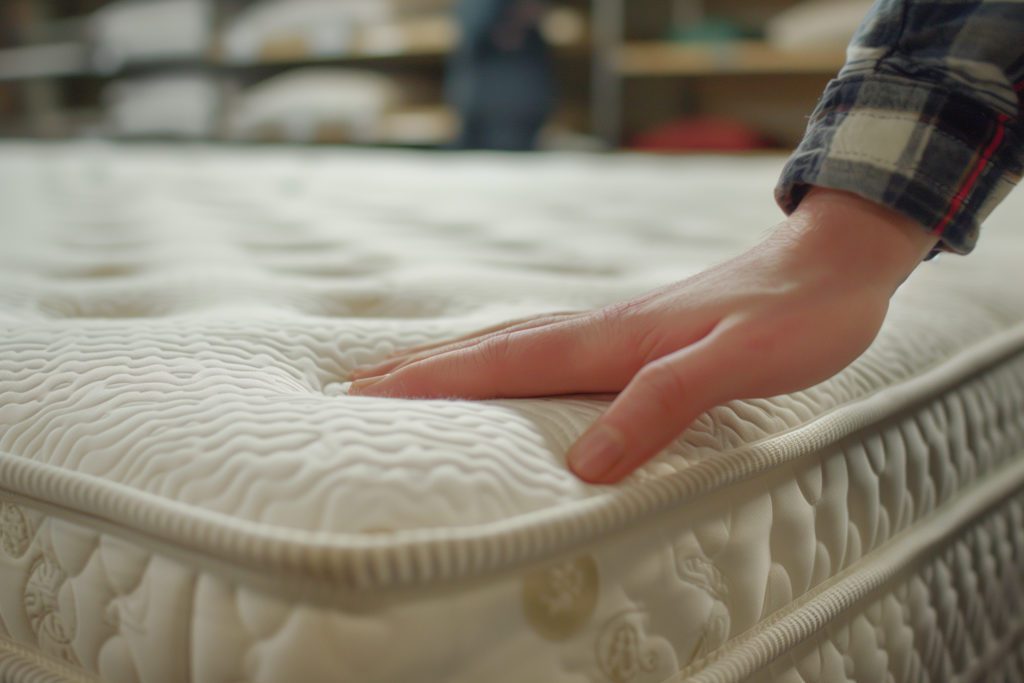
What is The Healthiest Sleeping Position? How the Right Sleeping Position Can make a Difference
Are you sleeping right? Learn how your sleeping position impacts your health and discover the best ways to optimize your sleep.

It’s 10:40 p.m. Your sheets are made from breathable cotton, you’ve done 15 minutes of yoga, and you’ve been careful not to look at your cell phone before bed—well done, you’re on your way to better sleep hygiene!
Now, let’s improve things even further by considering your body position once you get into bed. It seems like a small detail, but actually the way we lie can offer certain health benefits. Sleep position is less important when we’re young, but as we age, and the body is dealing with certain issues, the way we lie can help or hinder the body’s healing process through the night.
Getting into the habit of adopting the healthiest sleeping position can dramatically enhance both the quality and quantity of our sleep—and better sleep means improved overall health. In this article, we’ll explore how adopting the best sleeping position can be a game-changer for your nightly sleep ritual.
The Anatomy of Sleep
Sleep—we all know we need it (and we feel pretty bad if we don’t get enough of it). But what makes sleep so necessary? The truth is, scientists aren’t 100% sure why we need sleep, but they’re working on it—and these are some of their theories:
- Energy conservation
- Cellular restoration
- Brain function
- Emotional well-being
- Weight maintenance
- Proper insulin function
- Immunity
- Heart health
What we can deduce from this is that sleep is not only a time for rest, but a complex process involving various stages, each crucial for our physical and mental recovery from the day’s stresses and strains.
How we lie during sleep can either support or hinder this recovery process. Each position—sleeping on your back, sleeping on your side, sleeping on your stomach, and the fetal position—has unique impacts on our body. These positions can affect everything from spinal alignment to breathing patterns.
Let’s take a look at some of the common sleeping positions in more detail.
Back Sleeping
Benefits of Back Sleeping
- Promotes Spinal Health: Sleeping on your back allows your spine to rest in a neutral position, which reduces pressure on your discs and encourages proper alignment. This helps distribute your body weight evenly, reducing strain on any single point along your spine.
- Mitigates Back Pain: Back sleeping can help alleviate chronic back pain, because it supports the natural curve of the lumbar spine. This can be particularly beneficial if it’s your lower back causing discomfort.
- Reduces Acid Reflux: If you’re on your back and your head elevated, your stomach is positioned below your esophagus. This can help prevent stomach acid from traveling back into the esophagus, reducing symptoms of acid reflux and heartburn.
- Prevents Facial Wrinkles: Who knew your sleeping position could have beauty benefits? Unlike sleeping on your side or stomach, which can press your face against the pillow, back sleeping leaves your face free from any pressure. This can help minimize the formation of sleep lines and wrinkles.
- Improves Circulation: Back sleeping allows for better blood flow and less obstruction throughout the body. With no extra pressure on your arms, legs, or vital organs, your circulatory system can function more efficiently, enhancing overall health.
Drawbacks of Back Sleeping
- May Exacerbate Snoring and Sleep Apnea: When you’re on your back, the base of your tongue and soft palate may collapse to the back wall of your throat because of gravity. This obstructs the airway and can significantly increase snoring. If you have sleep apnea, you may find more frequent interruptions in your breathing.
- Could Be Unsuitable: Individuals with certain medical conditions may find back sleeping uncomfortable or even risky. For example, those with severe sleep apnea, some types of chronic back pain, or pregnant women in their second and third trimesters may be advised against this position.
- Requires Proper Pillow Support: For back sleeping to be fully beneficial, you need to use a pillow that keeps your neck in alignment with your chest and back. It can be tricky to find the perfect pillow, but it’s worth persevering!
Side Sleeping
Benefits of Side Sleeping
- Minimizes Snoring and Sleep Apnea: Side sleeping helps keep your airways open, reducing the likelihood of snoring and mitigating the symptoms of sleep apnea. It prevents your tongue and soft palate from collapsing into the back of the throat, ensuring a smoother airflow during the night.
- Ideal for Pregnancy: For expecting mothers, side sleeping (particularly on the left), is recommended. This position improves circulation to your heart, benefiting both mother and baby. It also helps alleviate pressure on your liver and kidneys, making it a safer and more comfortable option during pregnancy.
- May Alleviate Acid Reflux: Sleeping on your left side helps keep the stomach in its natural position. This prevents stomach acids from traveling back into the esophagus, offering relief to those suffering from heartburn or GERD.
Drawbacks of Side Sleeping
- Potential Shoulder and Hip Pain: Without proper support, the pressure of side sleeping can put pressure on your shoulders and hips, which can worsen existing problems. The weight of your body resting on these joints for an extended period may compress nerves and strain muscles, leading to soreness and stiffness.
- Improper Spinal Alignment: If you’re not positioned correctly, sleeping on your side can mean your spine is misaligned. An unsupportive mattress or the wrong pillow height can cause your spine to bend or twist unnaturally, leading to back pain and discomfort.
Stomach Sleeping
Benefits of Stomach Sleeping
- May Reduce Snoring: The primary advantage of stomach sleeping is its potential to diminish snoring. Why? Because it prevents your tongue from falling back into the throat, which in other positions can obstruct the airway, thereby reducing snoring and offering a quieter sleep environment.
Drawbacks of Stomach Sleeping
- Neck and Back Strain: When you’re on your front, you need to turn your head to one side to breathe, which can lead to neck strain and misalignment. Your neck may be twisted unnaturally for extended periods, causing discomfort and, in the worst cases, long-term musculoskeletal issues.
- Potential for Lower Back Pain: Lying on your front can place undue stress on your back because the natural curve of the spine is flattened, leading to potential lower back pain. The strain on the spine can lead to chronic back problems over time.
- Nerve Pressure and Numbness: The pressure exerted on muscles and joints in this position can compress nerves, leading to numbness, tingling, or even nerve pain. These sensations may not only disrupt sleep but can also be indicative of long-term nerve damage if the position is maintained night after night.
Fetal Position
Benefits of the Fetal Position
- Comfort and Security: Because it’s the way we are positioned in our mother’s womb, many (four in 10 of us, in fact) find the fetal position comforting. This emotional comfort offers a sense of security that can facilitate easier sleep onset and deeper sleep cycles.
- Reduces Snoring: Like side sleeping in general, the fetal position can help minimize snoring by keeping your airways open. Breathing is unobstructed, promoting a smoother sleep.
Drawbacks of the Fetal Position
- Muscle and Joint Discomfort: Staying curled up for several hours can lead to stiffness in the joints and muscles, particularly in the back, hips, and neck. This can result in pain and discomfort upon waking, and potentially long-term musculoskeletal issues.
- Restricts Deep Sleep: The tightness of this position may prevent the body from shifting into deeper, more restorative sleep stages. Adequate movement and alignment are essential for cycling through all stages of sleep effectively.
FAQ
What if I always wake up in a different position than I fell asleep in?
It’s completely normal! Most people change positions multiple times throughout the night without even realizing it. As long as you’re waking up feeling rested and without aches, your body is likely adjusting naturally to what it needs.
Is it bad to sleep in the same position every night?
Not necessarily, but if you wake up sore or stiff, it might be time to switch things up. Varying your sleep position or adjusting your pillow and mattress for better support can make a big difference.
What’s the best sleeping position for digestion?
Sleeping on your left side is often recommended for better digestion and to reduce acid reflux. This position helps your stomach and intestines work with gravity, making it easier for food to pass through.
Why do I feel sore after sleeping on my side?
It might be due to an unsupportive mattress or pillow. Side sleepers need a mattress that cushions pressure points like shoulders and hips, along with a pillow that keeps their spine aligned.
What’s the worst sleep position for back pain?
Stomach sleeping is usually the worst for back pain because it flattens the spine’s natural curve. If you must sleep this way, placing a pillow under your pelvis can help reduce strain.
Does my sleep position impact wrinkles?
Yes! Sleeping on your stomach or side can press your face against the pillow, contributing to sleep lines and wrinkles over time. Back sleeping helps avoid this.

Written by
Georgia Austin
Professionally trained copywriter, editor, and content marketing strategist with over 7 years of experience—working with brands like Nike, Siemens, Toshiba, Tommy Hilfiger, Culture Trip, and Klook.
Download Pillow
Get help
Press & News
Legal
Connect
X (Twitter)
Company
Copyright © Neybox Digital Ltd.



